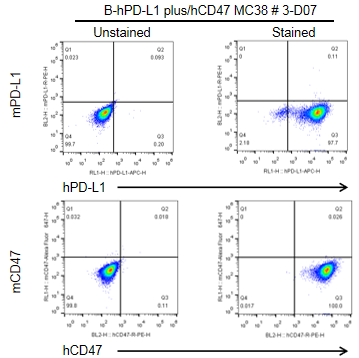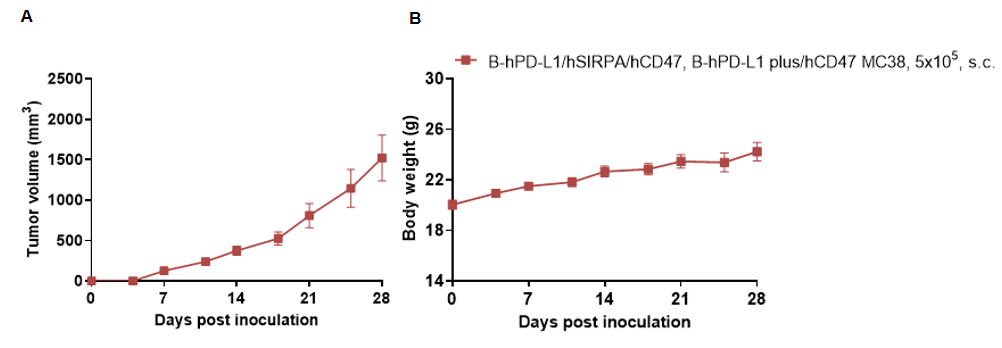|
Common name |
B-hPD-L1 plus/hCD47 MC38 | Catalog number | 320714 |
| Aliases |
CD274, PDCD1L1 IAP, MER6, OA3 |
Disease | Colon carcinoma |
|
Organism |
Mouse |
Strain | C57BL/6 |
| Tissue types | Colon | Tissue | Colon |
Description
The mouse Pdl1 gene and Cd47 gene were replaced by human PD-L1 and CD47 coding sequence in B-hPD-L1 plus/hCD47 MC38 cells. Human PD-L1 and CD47 are highly expressed on the surface of B-hPD-L1 plus/hCD47 MC38 cells.
Application
Protein expression analysis

PD-L1 and CD47 expression analysis in B-hPD-L1 plus/hCD47 MC38 cells by flow cytometry. Single cell suspensions from B-hPD-L1 plus/hCD47 MC38 cultures were stained with species-specific anti-PD-L1 and anti-CD47 antibodies. Human PD-L1 and CD47 were detected on the surface of B-hPD-L1 plus/hCD47 MC38 cells. The 3-D07 clone of B-hPD-L1 plus/hCD47 MC38 cells was used for in vivo experiments.
Tumor growth curve & Body weight changes

Subcutaneous homograft tumor growth of B-hPD-L1 plus/hCD47 MC38 cells. B-hPD-L1 plus/hCD47 MC38 cells (5x105) were subcutaneously implanted into B-hPD-L1/hSIRPA/hCD47 mice (female, 8-week-old, n=5). Tumor volume and body weight were measured twice a week. (A) Average tumor volume ± SEM. (B) Body weight (Mean± SEM). Volume was expressed in mm3 using the formula: V=0.5 X long diameter X short diameter2. As shown in panel A, B-hPD-L1 plus/hCD47 MC38 cells were able to establish tumors in vivo and can be used for efficacy studies.









